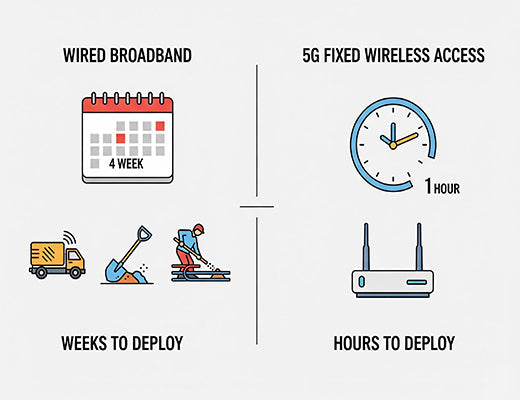
Navigating the 5G FWA IoT Market: A Guide to Business Connectivity in 2025
|
|
Time to read 5 min
|
|
Time to read 5 min
The 5G FWA IoT market is exploding, and for good reason. Businesses are rapidly discovering that 5G Fixed Wireless Access (FWA) is no longer just a futuristic concept—it's a powerful, reliable, and cost-effective alternative to traditional wired broadband.
This guide is for business leaders and IT professionals looking to understand the transformative potential of 5G FWA for business.
We'll break down what 5G FWA is, why it's critical for modern IoT and business continuity, and what to look for in an industrial-grade 5G router, using the Robustel R5020 Lite as a prime example of a production-ready solution.
I've spoken with countless business owners who share the same story of frustration. They're trying to open a new retail location, set up a pop-up event, or bring connectivity to a construction site, but they're stuck waiting weeks—or even months—for the local ISP to install a fiber or cable line. In today's fast-paced world, that delay means lost revenue.
But what if you could deploy gigabit-speed internet in minutes, not months? This is the revolutionary promise of 5G Fixed Wireless Access, and it's fueling the explosive growth of the 5G FWA IoT market. Let's be clear: this isn't the mobile hotspot you have on your phone. This is about using the power of the 5G network to provide a primary, enterprise-grade internet connection for your entire operation. It's a game-changer for business agility and a core application for any modern Industrial Cellular Router .

5G Fixed Wireless Access (FWA) is a method of providing broadband internet to a "fixed" location—like an office, a retail store, or an industrial facility—using a 5G cellular network instead of traditional wired connections like fiber, cable, or DSL.
In simple terms, a 5G FWA setup consists of:
1. A 5G FWA Router (like the Robustel R5020 Lite) installed at the location.
2. The router receives the 5G signal from a nearby cell tower.
3. It then converts this signal into a standard Wi-Fi and Ethernet network that all your local devices (computers, POS systems, IoT gateways) can connect to.
This creates a "virtual fiber" connection, delivering high-speed, low-latency internet without the wires.
This is the number one driver. With industrial 5G FWA, you are no longer at the mercy of the local ISP's schedule. You can bring a new site online in the time it takes to power on a router. This is essential for:
Even if you have a primary fiber connection, what happens when it goes down? I've seen entire businesses grind to a halt because a construction crew accidentally cut their fiber line.
In many areas, 5G FWA business plans are now highly competitive with, and sometimes even cheaper than, traditional wired broadband. When you factor in the elimination of expensive installation and construction costs, the Total Cost of Ownership (TCO) for 5G FWA becomes incredibly attractive.

Let's be clear: the free router the mobile carrier gives you is not built for a business. To properly leverage 5G FWA for business, you need an industrial-grade device.
The Robustel R5020 Lite is designed specifically for these applications.

The 5G FWA IoT market is fundamentally changing the way businesses think about internet connectivity. It offers a level of speed, flexibility, and resilience that was previously unimaginable. Whether you're looking for a primary internet connection for a new site, an unbreakable backup for an existing one, or a way to connect a growing fleet of IoT devices, 5G Fixed Wireless Access is a powerful and viable solution. By choosing a professional-grade industrial 5G FWA router like the Robustel R5020 Lite, you can confidently leverage this technology to make your business more agile, more resilient, and ready for the future.
A1: Modern 5G networks are incredibly reliable. For most business applications, a well-placed industrial 5G FWA router can provide uptime and performance on par with wired broadband. For mission-critical applications, it serves as the perfect, truly redundant backup, as it uses a completely different infrastructure than the local fiber or cable network.
A2: All major cellular carriers provide detailed coverage maps on their websites. It's important to check the maps for the specific carriers you plan to use with a dual-SIM router.
A3: Yes, absolutely. This is a core use case in the 5G FWA IoT market. A router like the R5020 Lite, paired with a cloud management platform like RCMS, is a scalable and secure way to provide connectivity and remote management for a large number of distributed IoT assets.